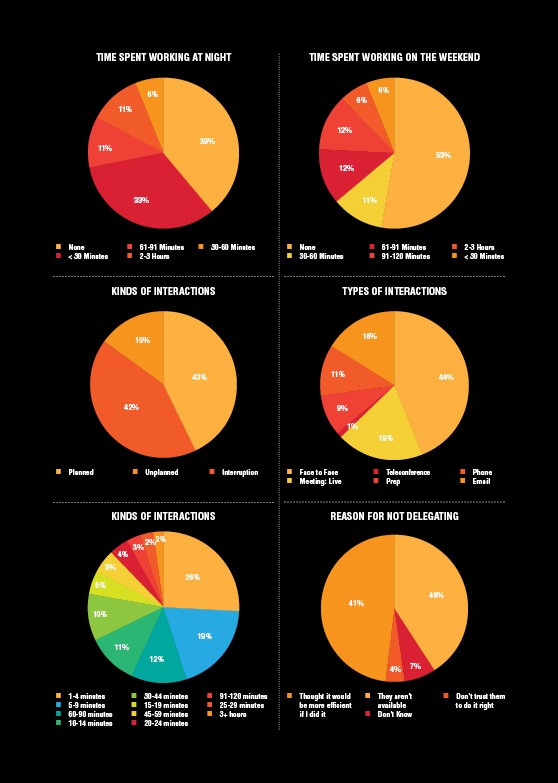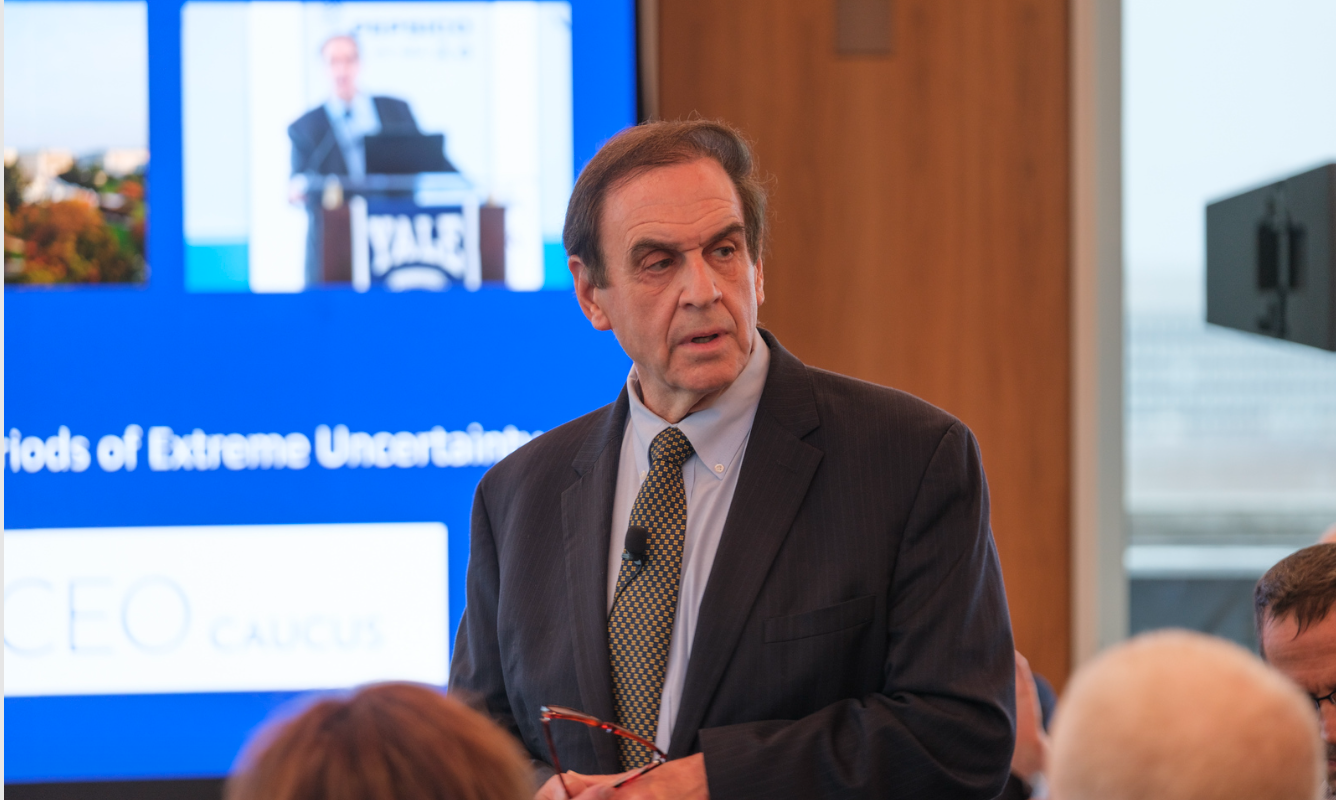2013 Executive Study: How Company Leaders Spend Their Time
The challenge: How can executives and senior leaders reduce their current workloads and invest more time in generating innovation and creating greater value for customers? Insigniam consultants shadowed 15 leaders from a healthcare system — including President, EVP, VP, and directors — for three days to capture a minute-by-minute, behind-the-scenes look at how they spent their time in order to determine how to increase efficiencies. It quickly became evident that the findings from this study would not be specific to healthcare executives but were common to executives from practically all industries.
Summary of key findings
The fundamental core of the work throughout the day for the executives was interaction with other people. Whether those interactions were via emails, meetings, reading reports, conference and video calls, fielding phone calls and voicemails, or casual interactions in the halls, 100% of the executives’ time was spent in one kind of conversation or another, the majority being unplanned.
Insigniam discovered that there were quite a few internal practices in managing these interactions that could be instilled to help executives reclaim some hours in the day, including inefficient meeting management and a lack of email and activity protocol.
- 66% of scheduled meetings attended were not meetings led by the executive.
- Email took up a large amount of executives’ time due to the volume of messages that needed to be read and answered. Open-door policies also contributed to executives being interrupted.
- 48% of tasks that could be delegated were not, because leaders felt it was quicker to complete tasks themselves rather than hand them off to someone else.
- Leaders also did not schedule time for themselves to complete tasks that were asked of them and relied on their memories for meeting content and to follow up on requests.
- 1,339 hours of all employee time — not just executives — was spent in meetings. This adds up to 140 10-hour workdays over the 45 day period that Insigniam shadowed these executives.
Insigniam concluded that implementation of a few additional effective, efficient practices would free up more time for the leaders. These practices included:
- “No meeting time zones” for director-level and above
- System-wide meeting management protocol
- A standard slot of time for system-wide activities (i.e. rounding, office hours)
- System-wide email protocol
- Scheduling and honoring time to complete tasks and preparations for meetings, travel, etc.
- Structures for rising leaders to take on certain tasks
Time
On average, each of the leaders that Insigniam shadowed worked 10 hours per day. Their average daily start time was 7:30 a.m. and the average daily end time was 5:30 p.m. In addition, 46% of leaders devoted between 30 and 90 minutes to daily travel.
However, 28% of leaders spent at least 30 minutes working at night and 41% spent at least 30 minutes working on the weekends. Leaders typically used this time to read and respond to emails that they were unable to attend to during the day or the workweek.
Interactions
Insigniam observed 81 planned one-on-one interactions, 130 unplanned one-on-one interactions, 33 planned meetings with 15 or more participants, three unplanned meetings with 15 or more participants, 68 planned meetings with between three and 14 participants, and 22 unplanned meetings with between three and 14 participants.
More than half of the executives’ interactions were unplanned or interruptions, and 63% of them involved face-to-face contact or an in-person meeting. Multitasking was only observed in 5% of interactions, and 91% of those multitasking activities were reading or responding to emails.
Types of interactions
26% percent of the interactions were short, between one and four minutes. However, longer interactions between 30 and 44 minutes and 60 and 90 minutes accounted for 10% and 12%, respectively.
The total time for all the participants in the meetings observed over the 45 day period — including all planned or unplanned interactions involving three or more people — occupied 1,339 hours of total employee time, which is the equivalent to 140 10-hour workdays.
Length of interaction
In terms of delegation, 95% of observed interactions were required to be done by the person who was being shadowed. Ninety percent of requests were also required to be brought to that person. When asked why the request or interaction could not be delegated, 48% of executives responded that they thought it would be more efficient if they did it themselves.
Conclusions and recommendations
Through shadowing these executives, Insigniam was able to determine a number of recommendations that created opportunities for increased efficiencies in the workplace, allowing executives the chance to free up time from less critical activities and focus their efforts on ways to innovate, improve business practices, and work on developing new leaders.
Meeting time
Meetings occupied 1,339 hours of total employee time over the 45-day period executives were observed. In 66% of meetings attended, the leaders did not lead the meeting. In many instances, leaders were at meetings as non-interactive participants, in attendance to be aware of information rather than offer insight.
Implementing meeting management practices would have a material impact on freeing up time. A “no meeting time zone” was suggested for director-level employees and above so that leaders could have dedicated time for focus on innovation, talent development, and more. Other practices include basic, yet often overlooked, principles for meeting management:
- Sending an agenda with the meeting invitation to determine need for attendance
- Communicating about meeting attendance necessity
- Sending detailed minutes of meetings so that attendance for information is not mandatory
- Sending a representative who can take detailed notes and relay information to whomever necessary
Emailing
The mass of emails to read and respond to was also occupying large amounts of time. System-wide email protocol is another lever for freeing up time.
Possible practice: Setting expectations in the email by using terms such as Request, Inform, Urgent, Delivery, Response, Share, Offer, or Action in the subject line of each email. In the first line of the email include dates for delivery of response for the email, or include if no response is required.
Control of Time
Many of the leaders we shadowed did not schedule time to complete tasks that were asked of them. They very often relied on their memory for meeting content and to follow up on requests.
Possible practices: scheduling “do not disturb” meeting time in the calendar for work that has to get done such as planning and prep time, travel time, and other action items.
Interruptions
Many leaders worked with an open door policy, inviting interruption. Unanimously, this was done so that their staff felt taken care of and heard. Many leaders worked reactively rather than proactively.
Possible practice: Implementing daily or weekly office hours would allow for leaders to maintain this open door atmosphere while honoring their calendars and other accountabilities.
Delegating Tasks
Forty-eight percent of interactions that could be delegated were not. Using the justification that “I can do it faster,” most leaders thought it to be more efficient to complete it themselves, rather than turn it over to someone else.
Within each department shadowed, there were several rising leaders. Creating structures and practices for these leaders to take on secondary tasks would create more time and openings for those we shadowed to focus on primary accountabilities.
That’s where change starts. For executives in all industries, time is literally money. With a few adjustments to how those leaders use their time — like implementing standard, system-wide protocols and delegating tasks that can be done by others — they can spend that capital more wisely, reinvesting it in creating innovation and value for customers.




